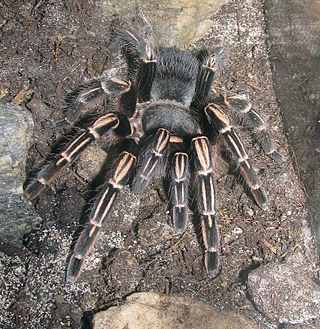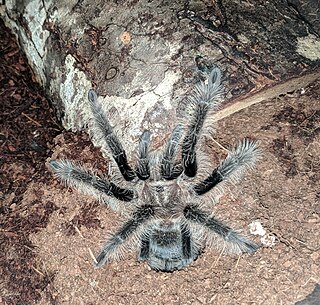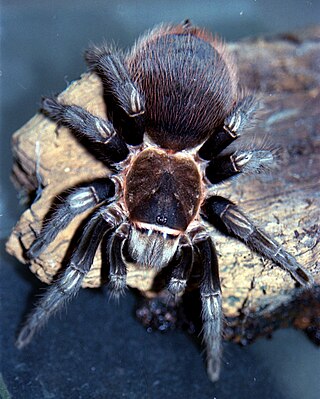
Avicularia is a genus of the family Theraphosidae containing various species of arboreal tarantulas. The genus is native to Panama, the Caribbean and tropical South America. Each species in the genus has very distinguishable pink foot pads.

Brachypelma is a genus of spiders in the family Theraphosidae (tarantulas). They may have bodies up to 6 cm long with legs of similar or greater lengths. Some species have brightly colored legs, with red or orange marks and rings.

Aphonopelma is a genus of tarantulas native to the Americas. It includes nearly all the North American tarantula species north of Mexico and a considerable percentage of the tarantula species that range into Central America. Most are fairly large tarantulas with leg spans of 6 in (16 cm) or more. Like most New World tarantulas, all species of Aphonopelma have urticating hairs. Despite their fearsome appearance, these tarantulas are not harmful to humans and some species are popular in the pet trade. With about 90 species described so far, Aphonopelma comprises about 10% of the total number of described tarantula species. However, their taxonomy is poorly understood and species are difficult to tell apart, especially those that are brown or black without other pattern. Therefore, the actual number of species is unknown, with more species likely to be identified in the near future. In captivity, they are usually fed crickets; in the wild, they eat most insects, including crickets, grasshoppers, cockroaches, mantises, and beetles.

Brachypelma smithi is a species of spider in the family Theraphosidae (tarantulas) native to Mexico. It has been confused with Brachypelma hamorii; both have been called Mexican redknee tarantulas. Mexican redknee tarantulas are a popular choice as pets among tarantula keepers. Many earlier sources referring to B. smithi either relate to B. hamorii or do not distinguish between the two species. B. smithi is a terrestrial tarantula native to Pacific coast of the Mexican state of Guerrero.

Chromatopelma is a monotypic genus of South American tarantulas containing the single species, Chromatopelma cyaneopubescens. Commonly known as greenbottle blue tarantulas due to their metallic blue legs and blue-green carapace, they are very active and fast-growing tarantulas that are particularly attractive to hobbyists. They are native to the Paraguaná Peninsula.

Psalmopoeus is a genus of the family Theraphosidae containing various species of tarantulas. The genus is native to Trinidad and Tobago, Colombia, Ecuador, Venezuela, Guyana, Brazil, Belize, Panama, Nicaragua, Costa Rica, Mexico, Guatemala and Honduras. All of these tarantulas are arboreal in nature, Psalmopoeus victori being the first arboreal tarantula of Mexico.

Tliltocatl albopilosus is a species of tarantula, also known as the curlyhair tarantula. The species' native range is Nicaragua and Costa Rica. They are largely terrestrial, opportunistically burrowing spiders.

Tarantulas comprise a group of large and often hairy spiders of the family Theraphosidae. As of December 2023, 1,100 species have been identified, with 166 genera. The term "tarantula" is usually used to describe members of the family Theraphosidae, although many other members of the same infraorder (Mygalomorphae) are commonly referred to as "tarantulas" or "false tarantulas". Some of the more common species have become popular in the exotic pet trade. Many New World species kept as pets have setae known as urticating hairs that can cause irritation to the skin, and in extreme cases, cause damage to the eyes.
Grammostola anthracina is a species of spider belonging to the family Theraphosidae (tarantulas). It is found in Uruguay, Paraguay, Brazil, and Argentina.

Brachypelma albiceps is a species of spider in the tarantula family, Theraphosidae. It is known as the Mexican golden red rump tarantula or the Amula red rump tarantula. The carapace is a light golden color and the abdomen dark, covered with long red hairs. Females typically live for about 15 years. Males usually live about 5 years or up to 12 months after the last molt.

Eucteniza is a genus of trapdoor spiders in the family Euctenizidae containing at least 14 species occurring in Mexico and the southern United States. Species are distinguished by a softened rear portion of the carapace, and males possess large spines on the first two pairs of walking legs that are used to hold females during mating. Like other trapdoor spiders they create burrows with a hinged lid, from which they await passing insects and other arthropods to prey upon. Many species are known from only one or two localities, or from only male specimens. More species are expected to be discovered. Eucteniza is closely related to spiders of the genera Entychides and Neoapachella.
Aphonopelma chamberlini, also known as the Paso Robles rusty red tarantula, is regarded by some sources as a tarantula species endemic to California, and by others as synonymous with Aphonopelma iodius.

Aphonopelma marxi is a species of spider in the family Theraphosidae (tarantulas), found in United States. Aphonopelma behlei and A. vogelae, at one time considered separate species, are now considered to be synonyms.

Sericopelma is a genus of tarantula, found in Central America from Nicaragua to Panama. The limits of the genus and its distribution have long been confused; it is closely related to the genus Aphonopelma. Sericopelma species are among the largest found in Central America. They can be kept as pets, although at least one species has been described as "very aggressive".
Tliltocatl aureoceps is a possible species of spider in the family Theraphosidae (tarantulas). The World Spider Catalog regards it as a nomen dubium. Only one female has been described; this was captured in the Florida Keys, but is likely to have been imported from Mexico.

Tliltocatl epicureanus is a species of spider in the family Theraphosidae (tarantulas), found in the Yucatán Peninsula of Mexico.
Sandinista lanceolatum is a species of spider in the family Theraphosidae (tarantulas), native to Nicaragua and Costa Rica.

Tliltocatl sabulosus is a species of spider in the family Theraphosidae (tarantulas), found in Guatemala.

Tliltocatl is a genus of North American tarantulas that was split off from Brachypelma in 2020. They are also large burrowing tarantulas, but don't have the striking red leg markings of Brachypelma species. A female T. vagans can grow up to 50 mm (2.0 in) long and legs can get as long as 55 mm (2.2 in). They are found predominantly in Mexico, with some species native to Central America. The name is derived from two Nahuatl words, "tlil", meaning "black", and "tocatl", meaning "spider". Habitat destruction and collection for the pet trade has led to this and Brachypelma to be protected under International Convention on International Trade of Endangered Species rules, beginning with B. smithi.

Sericopelma embrithes is a tarantula that is native to Panama. To date, only specimens from Barro Colorado Island have been studied. Like other tarantulas, it is relatively large compared to other spiders. It can grow up to 59 mm long, including its chelicerae. S. embrithes is data deficient according to the IUCN.














